A gang of Franken-broccolinis.
As mentioned in the previous post, https://obsessivenutritioncompulsive.wordpress.com/2013/07/28/fish-head-eating-tips/, I have my own vegetable garden which is pretty productive I must say. And so I’d like to rant a bit about backyard veggie patches and how to take care of them.
The thing with veggie garden is, they aren’t as hard to maintain as they seem. Just look at my mutated, half-dead Franken-broccolinis as reliable references(gang of vicious vegetables); they look pretty dead, but they really aren’t, and they’re bearing ‘floret stems’ nearly every week. I basically need to cut the broccolini stems and store them in bags in the fridge because I have surpluses of them(backyard surplus crop).
Broccolinis and lots of other veggies aren’t hard to take care of at all. You just leave them be. But the thing with my mutated broccolinis is that I’d performed surgery on them and turned them into ‘Franken-broccolinis’. Now, let’s have a break from the main topic of discussion and let me tell you a short and pithy story about the origin of my Franken-broccolinis(based on true events);
My broccolinis are actually pretty ancient for vegetable plants, I planted them as seedlings back around mid-summer(which is around end of December last year in the Southern Hemisphere) and getting into Autumn, as fledgling young adult plants, they began to bolt, after producing for us a couple of lots of broccolini stems. Bolting is when plants produce an elongated stem with flowers on them, which happens when they’re old enough to reproduce, or when the temperature is unexpectedly hot. The flowers will gradually produce seeds which you can collect to grow more of the same plants.
(This seedling is bolting way beyond her years! A pretty disturbing image)
The deadly side of bolting is this… dun dun dun! If left long enough, it makes your plants become chewy, tough, inedible, much like your grandparents’ droopy, leathery skin(just kidding). But luckily, there’s a cure for bolting(but no cure for aging in humans thus far, unfortunately), which is by picking the elongated shoot/stem off. As soon as they pop up, take them out. And that’s what I’ve done with my broccolinis. However, the problem with the broccolinis is… I have about six of them and I’m the only person in my family who takes care of the garden(technically, all the veggies should be mine). Sometimes I would miss a couple of bolted stem, or they’re hidden behind masses of leaves, then it would be too late! But I always pick them off in the end though. Sometimes bolting is just a part of nature, and you’ve got to admit that your plants are getting old(They’re commercial vegetable plants so they will have a fix ‘producing’ age). However, I decided to bend the rules and go against the naturals, and kept very tirelessly picking off bolted stems. As a result, I’ve lugged my broccolinis through over these long months, and now they’ve become pretty mangled-looking ‘Franken-broccolinis’.
I also must confess that I’d created ‘Franken-bokchoys’ before, from the two that I had in my garden a while ago. But the thing is, bokchoys aren’t no broccolinis. They don’t look very plant-like and so when they start to mutate, they become very scary. They look like your regular packaged bokchoy from the supermarket that has been spilled on with radioactive substance. So as a result, the bokchoys were quickly finished off, and uprooted, rid of their misery.
A lady who was also an amateur gardener said she couldn’t even bear to uproot her highly neglected bolted vegetable plants because they looked “alive” and “crawling”. I totally agree. It’s a tough job.
One of the few things you must have in mind before you have a backyard veggie patch would be about uprooting creepy, crawling-looking, mutated veggies.
Anyways, back to my tour of the veggie garden;
My beautiful hydro lettuces(or are hydro lettuces only the wavy/curvy edged ones? Well, the green one is anyways). I was so happy to find that(they’d come in a container of six) at least one of them had anthocyanin in it(the lovely purple one)! Anthocyanin is a natural purple pigment that’s also an antioxidant. They’re found in veggies i.e. eggplants, purple cabbages, or wild rice(I recommend wild rice pudding for sweets-eaters). The lettuces grow over winter(It’s around mid-winter right now)
Recycling containers residers; a little ‘curly burly’ kale and two celeries.
A good tip for you amateur gardeners out there; don’t put your plants in containers. They don’t grow well at all, the draining is horrible, and fungi, etc. thrives in the dark, damp surroundings(The fungi steals your plants’ nutrients) but if you’re desperate you can grow plants in there, but they just won’t be very happy veggies(My celery grew into a dwarf, and develops very slowly, same goes with my container kale). As an extra bit of info, kale is great for your skin, its extracts are sold by expensive Japanese skin products i.e. FANCL(kale’s one of the ‘superfoods’ apparently) so growing them in your own backyard instead of purging your purses out at the supermarket is a good idea. Kale are not weak plants.
A weak, crappy plant would be baby spinach. Those bastards. Mine died off pretty quickly and didn’t grow very well(only made small spinach patches). Better off buying them fresh at the supers. They could have also died as a result of my tendency to violently shoot my plants with water when watering them. I’m like mother birds that violently stick food down their chicks’ throats. Eat water, you puny veggies.
My rutabaga or swede. May not be familiar to some of you; they’re kind of like turnip but tastes a thousand times better, and dwarfs turnips. They also sweeten up over winter(when the frosts get to them). So don’t eat them before then or you’ll just be eating a huge, big, purple turnip(I don’t think you get anthocyanin from them though because you peel the hard, pale purple outside skin for the edible inside root which is orangish-yellow)
I’m loving the purple tinge on its leaves(oldness?), which just means eating time for me. This was my last remaining swede survivor… sniffs. Gone now.
After murder. The thing with uprooting vegetables is, it can be a sad affair. Especially for someone who is so dedicated and lives amongst plants below herself like I do. I had felt so depressed when I had to uproot my broccoli plants, upon my mother’s order, to pave way for the new members of the garden(i.e. the lettuces and the kales). Because it’s time to make way for the new generation.
(Hence why people of the Jain religion(vegetarians) don’t devour root vegetables. It makes sense once you experience uprooting veggies yourself.)
But sadly, uprooting veggies does grow in ease over time. This swede only took me about 5 minutes to uproot and clean. ‘Chop’ ‘swift’ ‘chuck’. I still can’t imagine how some farmers can shoot their own lamb for dinner for their kids though. Was this fluffy, dad?
Anyways, as a summary to the post, here are some helpful tips for to-be or amateur(than I am) gardeners:
1. Pick hardy veggies otherwise you’ll have to spend a lot of time babysitting your plants. These include; broccoli(but caterpillars in summer can become a minor issue, unless your region is prone to butterfly/moths swarms attacks), broccolini, kale, root plants, etc. Weak plants include; lettuces, baby spinach, tomatoes, etc. You can see your local seedlings sellers for better and more accurate information.
2. Invest in good, organic fertilizers. Without fertilizers, you’re only going to get pathetic looking vegetable plants. Buy a pack of soil labelled contain organic fertilizers like mulch or something. Don’t get a highly concentrated fertilized soil or your plants will die, because it would be like dumping a load of crap onto your vegetable. Toxic or nutrients overload?
3. Be aware of the annoying issues of bloody weeds. The most annoying ones are the small shoots of grasses or other weeds that pop up everywhere and are super hard to pull out with too large gardening gloved fingers. This is something you have to accept and spend half an hour every weekend to get rid off(good news is they grow much slower in winter). If you’re really lazy, a solution would be to grab a mini hoe and rake the ground around your veggies where the weeds are sprouting up from. This will temporarily uproot the weeds; they may or may not die(weeds have the tendency to re-root themselves even when they’ve been pulled out. Bloody smart things). The good news is that dandelion, one of the annoying weeds that may pop up in your garden is actually edible!(only young ones with no white saps spewing out off) http://newurbanhabitat.com/2010/03/04/dandelions-are-super-foods/ for more info.
4. Keep picking off bolted stems, but keep in mind that after bolting, your veggies’ texture may become chewier. Some of my broccolini stems get pretty chewy and I’d have to resort to eating only their top half or the floret parts. That’s where the nutrients are mostly kept in anyways. Also, as an extra bit of info, broccoli leaves along with many other plants’ are edible. http://www.oprah.com/health/Nutritional-Benefits-of-Eating-Peels-Stems-and-Rinds/4 more info on broccoli and other leaves. Go for the tender leaves though for the most digestibility and be aware that excessive consumption of broccoli stems or leaves can lead to constipation because of built up bulk(i.e. the too much fibre effect) in the bowels.
*Scroll to the bottom of the page for the real truth about broccoli nutrients!*
5. Water a lot or less. The more you water, the more grateful your plants will be towards you, and the more they will grow. If you live in an area with frequent rainfall, watering everyday is not needed but you’ll just get your produces a bit slower if you don’t. Don’t be afraid to drown your seedlings or plants with water. They love it!
About broccoli and their nutrients:
So, upon further research and actually reading the oprah website link I’d put down, turns out that the stalks(I’m assuming the tender stems) actually rival the broccoli florets in nutrition. I’ve no idea where I got the idea that the florets are the most nutritious part from(I suppose from the fact that we normally only eat the top parts of the broccoli heads?)
From the website http://whfoods.org/genpage.php?tname=dailytip&dbid=189 :
The florets and stems of broccoli are very similar in their nutrient content, and both are excellent parts of broccoli to include as part of your Healthiest Way of Eating. The amount of most B vitamins, minerals, and fiber are very similar in the two parts of the plant (on an ounce-for-ounce basis). The largest difference I’ve seen documented in the research literature involves beta-carotene, which is about seven times more plentiful in the florets than in the stems. On an ounce-for-ounce basis, the darker green florets also contain more chlorophyll than the lighter green stalks. Since the stalks take a little longer to steam than the florets, it is best to begin cooking them first and after about two minutes add the florets to the steamer.
You didn’t mention broccoli leaves in your question, but the leaves of the broccoli plant are also excellent sources of nutrients. They are actually higher in beta-carotene than the florets and can contain phytonutrients that aren’t found in the stems and florets.
I bolded the important bits for lazy arses.
Oprah also agrees with this statement on her website:
A one-ounce serving provides 90 percent of your daily vitamin A requirement (the florets deliver only 3 percent)
Wow. So that totally stumped my whole nutritious florets theory(they’re referring to the leaves)
and also from this website: http://www.nutrition-and-you.com/broccoli.html
Broccoli leaves (green tops) are an excellent source of carotenoids and vitamin A; (provide 16000 IU of vitamin A per 100 g) contain these compounds several times greater than that in the flower-head.
What you should be careful about eating broccoli leaves and stems though, is that they can sometimes be ‘overwhelmingly’ fibrous(You’d know if you own broccoli plants in your garden) In case you haven’t noticed, we aren’t cows or other herbivores that have a second stomach to double digest and break down some tough cellulose of plants then regurgitate it up to eat(just kidding, that’s more with feeding penguin parents). And we do lack some enzymes to digest some cellulose structures of plants. Nevertheless, eating vegetables is obviously very good for your health and for maintaining healthy body weight, because we aren’t complete carnivores. There are plenty of long-living, healthy vegans out there to prove the point, and every culture(I’m pretty sure) commends including veggies in your diet.
Anyways, speaking of fibrousness, I had this idea way back that throwing a huge broccoli stalk away is such a waste of food! So I did some research on whether they were edible, and came up with this blog: http://livingthefrugallife.blogspot.co.nz/2008/12/tiny-tips-broccoli-stalks.html I swear, that woman is dang frugal. I’d have to hang my frugal belt up for her. So, she claims stalks are edible, and regularly eats them. She shaves off the tough skin of the stalk then chops up the soft-ish middle part and use them in stir-fries. I’m sure the broccoli stalks would have some nutrients in them too, because after all, the nutrients, etc. is transported through out the plant from the soil via the xylem(primary school biology dejavu?) just may not be very concentrated and all that good.
A rule of thumb for me, on eating foreign parts of a vegetable is, ‘if you literally can’t chew into it when it’s uncooked, then it’s probably no good cooked’. Inedible plants exemptions include artichokes(the hearts are delicious in a bit of olive oil), and some toxic vegetables like eggplants, spinach(not baby), etc. that tastes dodgy raw and must be cooked to kill some blah blah acids.
Who eats raw eggplants anyways? Some very stupidly hard-core raw foodist? Gwyneth Paltrow?
Also, on a side note, the Chinese have got it pretty sussed out with cooking vegetables(appropriately for releasing their nutritional value). Well, most of the time, except for with broccoli, lettuce and celery. These they ruthlessly sear in hot broth and scald them off most of their nutrients. More on the ‘Chinese way of cooking veggies’ later, or one can do one’s own research. The internet is one’s oyster. But that might make an interesting post though. We’ll see.
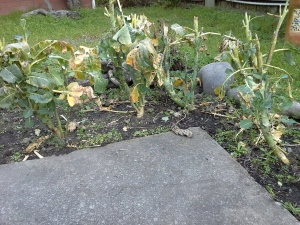
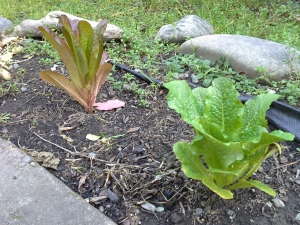
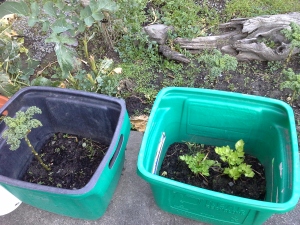
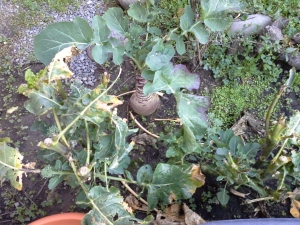
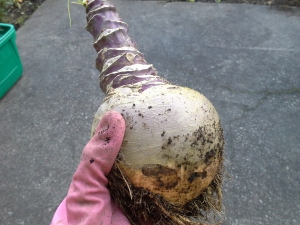








EAT WATER YOU PUNY VEGGIES!
LikeLike
Posted by Lynn | October 28, 2013, 8:19 amTrollolololololol over a period of time I really neglect them! I need to post new updates on my veggies over the summer. My salad mutated very creepily hahaha. You need to see this!
LikeLike
Posted by Obsessive nutrition compulsive | October 28, 2013, 8:46 am